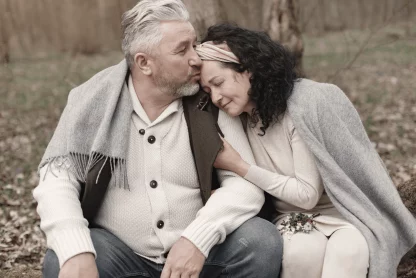Panic attack disorders are a terrifying and overwhelming experience that can strike without warning, leaving individuals feeling helpless and out of control. However, what many people don’t realize is that panic attacks can be more than just a temporary moment of fear – they can also be a sign of underlying psychological issues that require attention. Here, we will explore two credible psychological theories behind panic attacks and the hidden danger they pose to individuals. We will also provide Lifestyle changes to practice to help those who struggle with panic attacks to overcome this debilitating condition and improve their overall mental health and well-being.
Table of Contents
- What are panic attacks and their symptoms?
- Symptoms of Panic Attacks:
- Causes of Panic Attacks
- Treatment of Panic Attacks
- The impact of panic attacks on mental and physical health.
- The difference between panic attacks and anxiety attacks.
- The connection between panic attacks and panic disorder.
- Treatment of Panic Attacks and Panic Disorder
- The role of genetics and environment in developing panic attack.
- Lifestyle changes can help prevent panic attacks.
- FREQUENTLY ASKED QUESTIONS

What are panic attacks and their symptoms?
Panic attacks are episodes of sudden and intense fear or discomfort, accompanied by physical sensations such as heart palpitations, sweating, trembling, shortness of breath, and dizziness. The fear experienced during a panic attack is typically out of proportion to the actual danger present in the situation. Panic attacks can last from a few minutes to several hours and can occur unexpectedly or in response to a trigger. They are often associated with panic disorder, which is characterized by recurrent and unexpected panic attacks, as well as persistent worry about future attacks.
Symptoms of Panic Attacks:
The symptoms of panic attacks can be both physical and psychological. Physical symptoms may include:
- Rapid heart rate or heart palpitations
- Sweating
- Trembling or shaking
- Shortness of breath or feeling smothered
- Chest pain or discomfort
- Nausea or abdominal distress
- Dizziness or feeling lightheaded
- Chills or hot flashes
- Numbness or tingling sensations
- Feeling like you are losing control or going crazy
- Fear of dying
Psychological symptoms may include:
- Intense fear or terror
- A sense of impending doom or danger
- Feeling detached from oneself or reality
- Fear of losing control or going insane
- Feeling like things are not real or feeling unreal
Causes of Panic Attacks
The exact causes of panic attacks are not fully understood, but several factors are believed to contribute to their development. These factors include:
1. Genetics
There is evidence that panic disorder can run in families, suggesting a genetic component to the disorder.
2. Brain chemistry
Panic attacks are thought to be caused by an imbalance of certain neurotransmitters in the brain, including serotonin, norepinephrine, and gamma-aminobutyric acid (GABA).
3. Stress
Stressful life events or ongoing stress can trigger panic attacks in some people.
4. Anxiety sensitivity
People who are highly sensitive to the physical sensations of anxiety may be more prone to panic attacks.
5. Substance abuse
The use of certain substances, including caffeine, nicotine, and drugs like cocaine and amphetamines, can trigger panic attacks.
A study examines the comorbidity between panic disorder and depression and its impact on symptoms, impairment, and help-seeking behaviors.
Treatment of Panic Attacks
There are several treatments available for panic attacks and panic disorder, including:
1. Medication
Antidepressants and anti-anxiety medications are commonly prescribed to treat panic disorder. These medications work by regulating brain chemistry and reducing symptoms of anxiety.
2. Cognitive-behavioral therapy (CBT)
CBT is a type of psychotherapy that helps people identify and change negative thought patterns and behaviors that contribute to anxiety and panic attacks.
2. Relaxation techniques
Relaxation techniques such as deep breathing, progressive muscle relaxation, and meditation can help reduce symptoms of anxiety and panic attacks.
3. Lifestyle changes
Making lifestyle changes such as getting regular exercise, reducing caffeine intake, and getting enough sleep can also help reduce symptoms of panic disorder.
The impact of panic attacks on mental and physical health.
1. Mental Health Impacts
Panic attacks can have a profound impact on a person’s mental health. People who experience panic attacks often report feeling anxious, overwhelmed, and fearful. Panic attacks can also lead to the development of phobias and avoidance behaviors. These symptoms can significantly impact a person’s quality of life and ability to function in daily activities.
One study found that individuals who experience panic attacks have a higher risk of developing depression and suicidal thoughts compared to those who do not experience panic attacks.
2. Physical Health Impacts
Panic attacks can also have significant physical health impacts. During a panic attack, the body’s stress response is activated, leading to a surge of adrenaline and other stress hormones. This response can lead to several physical symptoms, including rapid heartbeat, chest pain, dizziness, and shortness of breath.
The physical symptoms of panic attacks can also lead to the development of other health conditions. For example, people who experience panic attack may be at a higher risk of developing cardiovascular disease due to the increased strain on the heart during a panic attack. Additionally, panic attacks have been linked to an increased risk of gastrointestinal disorders, such as irritable bowel syndrome.
3. Managing Panic Attacks
Fortunately, there are several evidence-based solutions for managing panic attacks and reducing their impact on mental and physical health. Cognitive-behavioral therapy (CBT) is a well-established treatment for panic disorder and has been shown to be effective in reducing the frequency and severity of panic attacks (Hofmann & Smits, 2008). CBT teaches individuals to identify and challenge negative thoughts and behaviors that contribute to panic attacks.
In addition to therapy, medication can also be an effective tool for managing panic attacks. Antidepressants and anti-anxiety medications can help regulate the body’s stress response and reduce the severity of panic attacks.
Panic attacks can have a significant impact on a person’s mental and physical health. However, with the right treatment, individuals can learn to manage panic attacks and reduce their impact on their overall well-being. If you are experiencing panic attacks, it is important to seek professional help from a mental health provider.
Environmental factors, such as major life stressors or traumatic events, may also trigger panic attacks in some individuals. Psychological factors, such as a history of anxiety or depression, may also increase the risk of developing panic disorder.
The difference between panic attacks and anxiety attacks.
While panic attacks and anxiety attacks share some similarities, there are key differences between the two. Some of the significant differences include:
1. Trigger
Panic attacks can occur without warning or a specific trigger, while anxiety attacks are usually triggered by a stressful event or situation.
2. Duration
Panic attacks typically last for a shorter period, usually a few minutes, while anxiety attacks can last for an extended period.
3. Intensity
Panic attacks are more intense and severe than anxiety attacks.
Physical symptoms: Panic attacks usually involve more physical symptoms than anxiety attacks.
4. Diagnosis
Panic attacks can be a symptom of panic disorder, while anxiety attacks may be a symptom of various anxiety disorders.
Relevant studies
Several studies have explored the difference between panic attacks and anxiety attacks. One study published in the Journal of Anxiety Disorders found that individuals with panic disorder experienced more severe and frequent panic attacks than those with other anxiety disorders, such as GAD and social anxiety disorder. The study also found that individuals with panic disorder were more likely to experience agoraphobia, a fear of being in situations or places where escape might be difficult.
Another study found that individuals with panic disorder reported higher levels of panic attack severity and frequency, anxiety, and depression compared to those with GAD.
While panic attacks and anxiety attacks share some similarities, they are distinct conditions that require different treatment approaches. It is essential to seek professional help if you experience panic attacks or anxiety attacks to learn to manage them effectively and reduce their impact on your overall well-being.
The connection between panic attacks and panic disorder.
1. Symptoms of Panic Disorder
Panic disorder is diagnosed when individuals have recurrent unexpected panic attacks and persistent worry about having future attacks. In addition to the symptoms of panic attacks, individuals with panic disorder may also experience:
2. Persistent fear of having another panic attack
Avoidance of places or situations where panic attacks have occurred in the past or where escape may be difficult or embarrassing
Significant changes in behavior, such as avoiding social situations or becoming overly dependent on others
3. Causes of Panic Attacks and Panic Disorder
The exact causes of panic attack and panic disorders are not fully understood, but research suggests that a combination of genetic, environmental, and psychological factors may be involved.
Studies have shown that panic disorder tends to run in families, suggesting that genetic factors may play a role. Additionally, brain imaging studies have found differences in the structure and function of certain brain regions in individuals with panic disorder compared to those without the condition, which may contribute to the development of panic attacks.
Environmental factors, such as major life stressors or traumatic events, may also trigger panic attacks in some individuals. Psychological factors, such as a history of anxiety or depression, may also increase the risk of developing panic disorder.
Treatment of Panic Attacks and Panic Disorder
Effective treatments are available for panic attacks and panic disorders. These may include:
1. Cognitive-behavioral therapy (CBT)
A type of talk therapy that focuses on changing negative thought patterns and behaviors that contribute to anxiety and panic attacks. CBT has been shown to be highly effective in treating panic disorder.
2. Medications
Certain antidepressant and anti-anxiety medications can be helpful in reducing the frequency and severity of panic attacks.
3. Mind-body therapies
It is important to seek treatment if you are experiencing panic attacks or panic disorder. Left untreated, panic disorder can significantly impact the quality of life and increase the risk of developing other mental health conditions, such as depression or substance use disorders.
Panic attacks and panic disorders can be debilitating conditions, but effective treatments are available. By understanding the symptoms, causes, and treatment options for these conditions, individuals can take steps to manage their symptoms and improve their overall well-being.
The role of genetics and environment in developing panic attack.
Studies have shown that panic disorder, which is characterized by recurrent panic attacks, has a strong genetic component. Family and twin studies have indicated that panic disorder runs in families and is heritable. In fact, it has been estimated that genetics account for approximately 30-40% of the variance in panic disorder risk.
It is important to note that while genetic factors contribute to the risk of developing panic disorder, they do not fully determine the development of the disorder. Environmental factors can also play a significant role.
1. Environment and Panic Attack
Environmental factors, such as stress and trauma, can trigger panic attacks in individuals who are already at risk for developing the disorder due to genetic factors. For example, a study found that individuals with a genetic vulnerability to anxiety disorders were more likely to develop panic attack disorder if they experienced a traumatic event, such as physical or sexual abuse.
Other environmental factors that may contribute to the development of panic disorder include substance use, chronic stress, and major life changes, such as divorce or the death of a loved one. A study found that chronic stress was associated with an increased risk of panic attacks in individuals with panic disorder.
2. Interaction Between Genetics and Environment
Recent research has focused on understanding the interaction between genetics and environment in the development of panic attack
A study found that genetic factors interacted with childhood adversity to increase the risk of developing panic disorder. Specifically, individuals who had experienced childhood adversity and carried a certain genetic variant were more likely to develop panic disorder than those who had not experienced adversity.
Panic attacks are a complex disorder with both genetic and environmental factors contributing to their development. While genetics contribute to the risk of developing the disorder, environmental factors such as stress, trauma, and substance use can trigger panic attack in individuals who are already at risk. Understanding the role of genetics and environment in the development of panic attacks can help inform the development of new treatments and interventions for this debilitating disorder.
Lifestyle changes can help prevent panic attacks.
Panic attacks are a common and distressing mental health issue that can significantly impact a person’s daily life. While panic attacks can be treated with therapy and medication, there are also several lifestyle changes that individuals can make to help prevent panic attacks. In this article, we will explore some of these lifestyle changes and the research that supports them.
1. Regular Exercise
Regular exercise has been shown to have a positive impact on mental health, including reducing symptoms of anxiety and depression. Exercise can also help to reduce stress and tension, which are common triggers for panic attacks. One study published in the Journal of Psychiatric Research found that individuals who engaged in regular exercise had a lower risk of developing panic attack than those who did not exercise regularly.
2. Balanced Diet
Eating a balanced and healthy diet is essential for overall physical and mental health. Certain foods and beverages, such as caffeine and alcohol, can trigger panic attacks in some individuals. It is important to identify any food or drinks that may trigger panic attacks and avoid them. A study published in the Journal of Affective Disorders found that a high intake of fruits and vegetables was associated with a lower risk of panic attacks.
3. Adequate Sleep
Sleep is crucial for overall health and well-being. Lack of sleep can lead to increased stress, anxiety, and irritability, which can trigger panic attacks. It is important to prioritize sleep hygiene and ensure that you are getting enough restful sleep each night. One study published in the Journal of Affective Disorders found that poor sleep quality was associated with an increased risk of panic attacks.
4. Relaxation Techniques
Relaxation techniques, such as deep breathing, meditation, and progressive muscle relaxation, can help to reduce stress and anxiety, which are common triggers for panic attacks. These techniques can also help individuals to manage the physical symptoms of panic attacks, such as rapid heartbeat and shortness of breath. One study published in the Journal of Psychiatric Research found that a mindfulness-based stress reduction program was effective in reducing symptoms of anxiety and panic disorder.
5. Avoiding Triggers
Identifying and avoiding triggers is an important aspect of preventing panic attacks. Triggers can vary from person to person but can include certain situations, places, or people. By identifying and avoiding triggers, individuals can reduce their risk of experiencing a panic attack. One study published in the Journal of Anxiety Disorders found that cognitive-behavioral therapy was effective in helping individuals to identify and avoid panic attack triggers.
6. Seeking Support
It is important for individuals experiencing panic attacks to seek support from friends, family, or mental health professionals. Support can help individuals to manage stress and anxiety and provide a safe space to discuss their experiences. One study published in the Journal of Affective Disorders found that social support was associated with a lower risk of panic attacks.
Lifestyle changes can play an important role in preventing panic attacks. Regular exercise, a balanced diet, adequate sleep, relaxation techniques, avoiding triggers, and seeking support are all effective strategies for reducing the risk of panic attacks. It is important for individuals experiencing panic attacks to work with a mental health professional to develop a comprehensive treatment plan that includes both lifestyle changes and other therapeutic interventions.
FREQUENTLY ASKED QUESTIONS
While panic attacks can be debilitating, they are treatable. With appropriate treatment and self-help strategies, individuals can learn to manage and reduce the frequency and intensity of panic attacks. Techniques such as cognitive-behavioral therapy (CBT), relaxation exercises, and medication can be effective in helping individuals overcome panic attacks.
The duration of a panic attack can vary, but most panic attacks reach their peak within 10 minutes and usually subside within 20 to 30 minutes. However, some individuals may experience shorter or longer panic attacks. It is important to remember that even though panic attacks can be distressing, they are not life-threatening.
Yes, panic attacks can be triggered by specific situations or events. Common triggers include crowded places, flying, public speaking, confined spaces, or traumatic experiences. Identifying and understanding these triggers can help individuals develop strategies to manage and cope with panic attacks effectively.
Yes, certain lifestyle changes can complement the treatment of panic attacks. Engaging in regular physical exercise, practicing stress reduction techniques like meditation or yoga, maintaining a balanced diet, getting adequate sleep, and avoiding excessive caffeine or alcohol consumption can contribute to overall mental well-being and help reduce the frequency of panic attacks. It is important to consult with a healthcare professional for a comprehensive approach to managing panic attacks.









